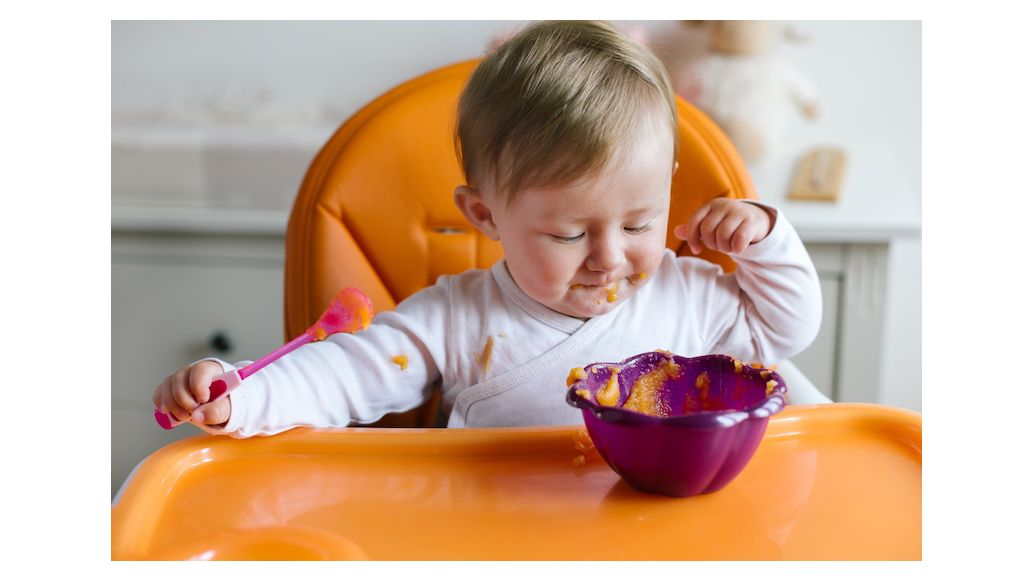Many children learn to eat by mimicking what they see their parents do. Babies with vision loss don’t have this opportunity and need to be taught in other ways. It can start by moving your baby’s hand to feel the bottle while being fed. If your son or daughter can’t see, he or she won’t know it was there. As you move toward self-feeding, there are three common ways to teach children with vision impairments how to eat.
- Hand-Under-Hand
- For this technique, your hand holds onto the spoon. Then your child’s hand rests on top of yours to feel what you are doing. It can help familiarize your baby with the activity while feeling secure. Narrate what you’re doing as you pick up the spoon, scoop up the food, bring it to their mouth, and set it back down.
- Hand-Over-Hand
- Another option is to let your baby hold the fork or spoon. Then you place your hand on top and guide their actions. As their confidence grows, you can lessen the support you give by holding their arm or removing your hands altogether. Explain each step to your baby as they complete it.
- Auditory Cues
- All of your movements need to be purposeful with this technique. Let your child have their own spoon dipped in food. If the spoon makes it into their mouth, they’ll begin to connect it with eating. As you feed your child, scrape the bowl just once to fill the spoon. Hold it up to your child’s mouth so they can smell it before eating it. Don’t scrape food off of their face; the goal is for them to mimic you. Return the spoon to the bowl with one clink. Start to go slower when feeding; eventually your child will grow impatient and begin to feed themselves.
Helpful Tips for Young Toddlers and Preschoolers
- Some children have trouble feeding themselves because they don’t like messy, sticky hands. Incorporate sensory play into their routine to desensitize their hands. You could use whipped cream, pudding, or rice for texture variation.
- Let your baby have a spoon early. Even if they just suck on it or bang it on the table. It will let them experiment with it. Also, encourage your baby to reach around and explore their tray for food like Cheerios.
- Talk and describe each step as you feed your baby. They can’t see your actions, so the narration helps them know what to expect.
- Use thicker foods when starting to let your child use a spoon. They stick better to the spoon and will limit your baby’s frustration. Mashed potatoes, applesauce, or yogurt are common choices.
- If your child has some vision, make sure there is a high contrast between the food and the plate. You can place puffs on a dark blue or black non-slip placemat. Try banana slices on a darker plate or peas on a white or yellow dish.
- Limit frustration by using a suction cup dish. It won’t move around when your child is eating. The high sides will also make scooping easier without food falling off the edge.
- Make switching from a bottle to a cup easier with a weighted sippy cup. Your child can set it down at any angle and the cup will right itself.
- As your child grows, many parents describe where the food is on the plate using a clock face. Before your child can tell time, you can use a compartment plate to keep food organized. Later you’ll tell them verbally, but for now your child can touch the food to determine what it is.
Tips for Older Children
- Solid foods like mashed potatoes or other utensils like a knife can be used as a buffer to help push food onto their fork.
- Teach your child to make sure the sharp side of the knife is down using this simple tip. The cutting edge is usually curved so it will rock on the plate when facing downward.
- A quick tip for restaurants: salt shakers usually have larger perforations in the top than pepper. At home you can use different shaped shakers or place a rubber band around one to help your child differentiate between them.
- When pouring cold liquids, your child can place their finger on the edge of the glass. This way they’ll feel when the glass is full as the liquid rises to the top.
- For hot liquids, your child can use an electronic liquid level indicator that beeps or vibrates when the drink reaches the top of the glass.
- As you start to pass serving dishes around the table, encourage your child to trace their fingers around the rim of the dish to find the serving utensil.
Children with vision loss can eat independently. However, you need to adapt and teach them differently. As your child grows, involve them in mealtime by letting them help prepare the meal, set the table, or clear the dishes. The responsibility teaches children new skills and builds their self-esteem.
Medical Disclaimer: The information provided on this site, including text, graphics, images and other material, are for informational purposes only and are not intended to substitute for professional medical advice, diagnosis or treatment. Always seek the advice of your physician or other healthcare professional with any questions or concerns you may have regarding your condition.








 France
France Australia
Australia



